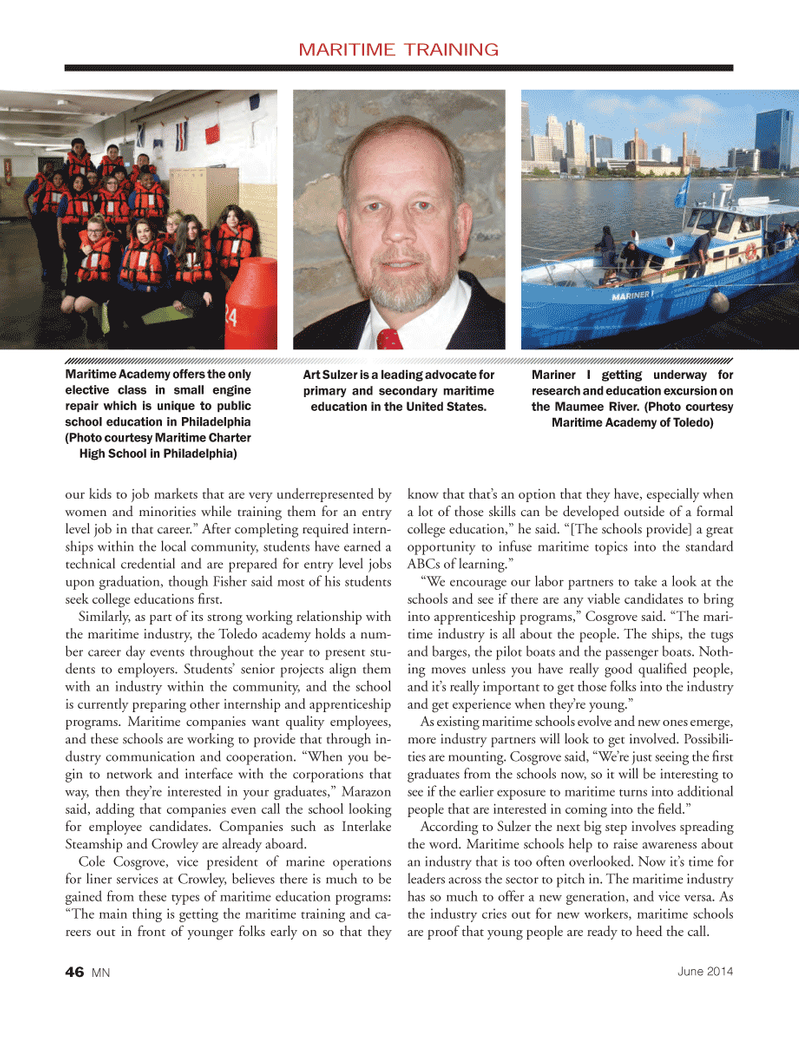
Page 46: of Marine News Magazine (June 2014)
Dredging & Marine Construction
Read this page in Pdf, Flash or Html5 edition of June 2014 Marine News Magazine
MARITIME TRAININGour kids to job markets that are very underrepresented by women and minorities while training them for an entry level job in that career.? After completing required intern- ships within the local community, students have earned a technical credential and are prepared for entry level jobs upon graduation, though Fisher said most of his students seek college educations rst.Similarly, as part of its strong working relationship with the maritime industry, the Toledo academy holds a num- ber career day events throughout the year to present stu- dents to employers. Students? senior projects align them with an industry within the community, and the school is currently preparing other internship and apprenticeship programs. Maritime companies want quality employees, and these schools are working to provide that through in- dustry communication and cooperation. ?When you be- gin to network and interface with the corporations that way, then they?re interested in your graduates,? Marazon said, adding that companies even call the school looking for employee candidates. Companies such as Interlake Steamship and Crowley are already aboard. Cole Cosgrove, vice president of marine operations for liner services at Crowley, believes there is much to be gained from these types of maritime education programs: ?The main thing is getting the maritime training and ca- reers out in front of younger folks early on so that they know that that?s an option that they have, especially when a lot of those skills can be developed outside of a formal college education,? he said. ?[The schools provide] a great opportunity to infuse maritime topics into the standard ABCs of learning.??We encourage our labor partners to take a look at the schools and see if there are any viable candidates to bring into apprenticeship programs,? Cosgrove said. ?The mari- time industry is all about the people. The ships, the tugs and barges, the pilot boats and the passenger boats. Noth- ing moves unless you have really good quali ed people, and it?s really important to get those folks into the industry and get experience when they?re young.? As existing maritime schools evolve and new ones emerge, more industry partners will look to get involved. Possibili- ties are mounting. Cosgrove said, ?We?re just seeing the rst graduates from the schools now, so it will be interesting to see if the earlier exposure to maritime turns into additional people that are interested in coming into the eld.?According to Sulzer the next big step involves spreading the word. Maritime schools help to raise awareness about an industry that is too often overlooked. Now it?s time for leaders across the sector to pitch in. The maritime industry has so much to offer a new generation, and vice versa. As the industry cries out for new workers, maritime schools are proof that young people are ready to heed the call. Art Sulzer is a leading advocate for primary and secondary maritime education in the United States. Mariner I getting underway for research and education excursion on the Maumee River. (Photo courtesy Maritime Academy of Toledo) Maritime Academy offers the only elective class in small engine repair which is unique to public school education in Philadelphia (Photo courtesy Maritime Charter High School in Philadelphia) 46 MNJune 2014MN June14 Layout 32-49.indd 46MN June14 Layout 32-49.indd 465/20/2014 10:24:42 AM5/20/2014 10:24:42 AM

 45
45

 47
47
